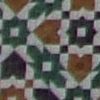Moroccan Tiles
Mosques, fountains, houses and furniture are decorated with mosaic tiles in Morocco.
The mosaic tile is characteristic in constructions of Moroccan-Andalusian architecture and Moroccan artisans have maintained that techniques.
Moroccan tiles are called the "zellige" .
Originally only the tiles in white and brown colors had been used around
in the 10th century.
Green and yellow were developed in the 14th century
under the reign of Merinids.
Red was started to use in 17th century.
Colorful tiles are developed now.
The raw material of tile is gray clay
from the vicinity of Fez.
It is mixed with water for a week to get
homogeneous.
This paste is poured to square molds and dried under the sun
for several days.
One side of the clay tile is dipped in color and then
dried. Then, they are baked in the kiln.
Silica is spayed to the clay tiles,
then ceramic tiles are now ready to be used for the zellige.
Squire,
star, diamond, round small ceramic tiles are used for the zellige.
Artisans
cut to shape the square ceramic tiles by special tools like chisel and
hammer.
Finally the small pieces of ceramic tile are lined upside down imaging the
mosaic pattern in the framework of construction.
Afterward the thin layer of cement is put and iron bars to
strengthen the whole or some reinforcements are also arranged. At the end cement
is poured and dried.
Then "it is
completed!!"




